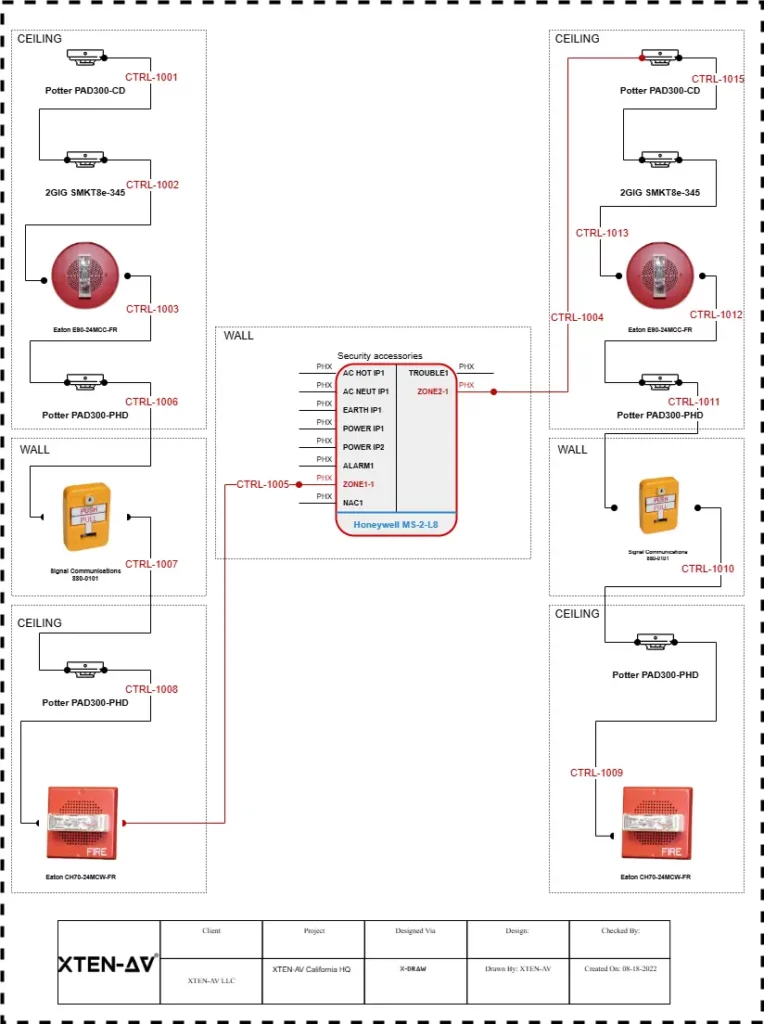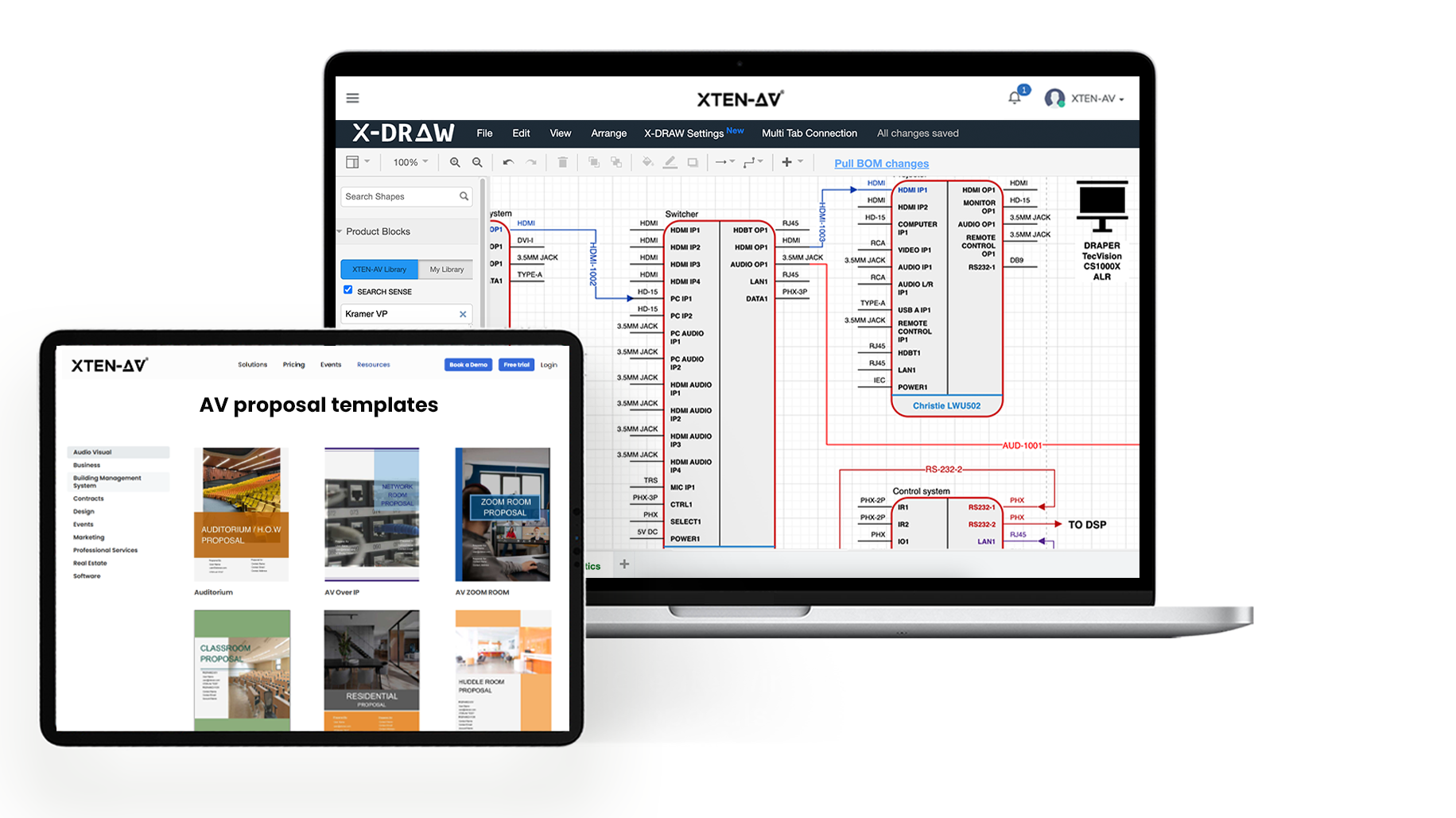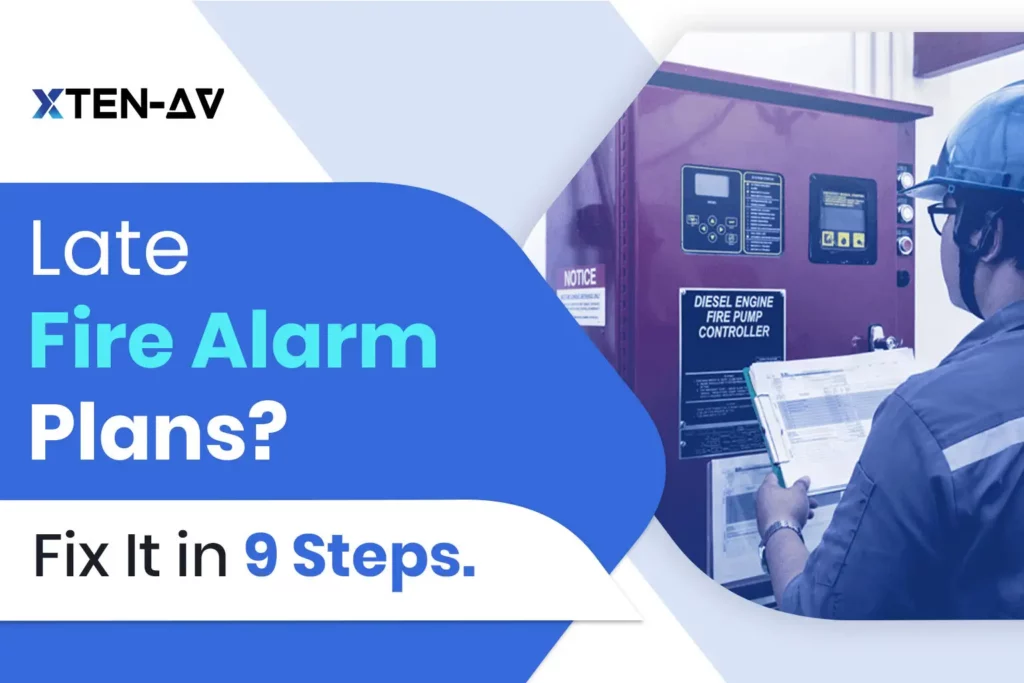When you have to create from scratch a plan for a fire alarm system, you learn that it goes beyond a mere device layout. It all has to do with making sure every smoke detector, alarm panel, and circuit functions well together, and all of these arrangements adhere to safety standards and comply with codes. This is the joint effort modern fire alarm system design software puts in.
Gone are the days of struggling through manual drawings or trying to remember spacing requirements. Today, fire alarm CAD software tools provide you with most of the features you would desire in such software. Some of those are Building Information Modeling (BIM) integration, pre-fabricated Smoke detector CAD symbols, automated placement, and compliance checks.
The modern-day software takes the speculation out of design and helps you spot potential issues before installation even begins. Moreover, they adhere to and follow the life safety compliances and regulations like NFPA 72 for optimal fire alarm system design. But which software is best for you and your needs.
Thus, we bring you a guide where we’ll look at the top options available. We will go through every aspect, ranging from feature-rich platforms to quick mobile solutions. It will help you know exactly which tool fits your workflow, be it drafting life safety designs for a hospital or upscaling a warehouse fire detection system.
Key Takeaways:
- Fire alarm CAD software streamlines creating accurate fire alarm system plans, improving efficiency and compliance for fire alarm system designers and integrators.
- Proper security system design ensures life safety designs meet industry codes while supporting fire detection systems, fire sprinkler systems, and smoke detector CAD symbols.
- Advanced fire alarm designer tools simplify fire alarm programming software tasks, enabling precise fire alarm system drawings for large-scale projects.
- Platforms like XTEN-AV enhance collaboration, real-time documentation, and automation with tools like X-DRAW and XAVIA. Hence, they ensure the fire alarm system design is faster, accurate, and scalable.
The all-in-one solution for your AV needs
Transform your audio-visual experience with XTEN-AV.
No Credit Card required
Best Fire Alarm System Design Software Platform
When you’re deep into a project, the last thing you want is to backtrack because of a design oversight. The right fire alarm system installation and design software can help you get it right the first time, mapping devices, checking coverage, and keeping everything code-compliant.
Some tools focus on detailed fire alarm CAD software layouts, while others make quick field changes easy. Here’s a look at the top options that can save you hours and keep your installations running smoothly.
1. XTEN-AV
If you’ve ever had to switch between three different programs to finish a single fire alarm or AV project, you’ll appreciate what XTEN-AV brings to the table. This cloud-based platform pulls everything, design, proposals, and project tracking, into one space.
You can drop device layouts, use ready-made symbol libraries, collaborate, and generate diagrams in an instant rather than building one from scratch. The added bonus is that this is collaborative; teams can observe each other updating in real time and thus avoid endless backup digital emails.
Best For
AV, fire alarm system designers who want one platform for design, proposals, and project management without switching to several different tools.
The all-in-one solution for your AV needs
Transform your audio-visual experience with XTEN-AV.
No Credit Card required
Features
- Access an unmatched library of Smoke detector CAD symbols, AV icons, and devices, 1.5 million+ products, anytime, anywhere, with no installs or asset hunting.
- Instantly generate professional fire alarm system drawings and precise Bills of Materials, eliminating hours of manual line connections, counts, and tedious data entry.
- Convert designs into polished, client-ready proposals in minutes, complete with your logo, cover pages, and detailed scope for a consistent, professional look.
- Work simultaneously with your team on the same fire alarm system plan, track edits, and roll back changes to prevent costly errors.
- Make instant updates from the office or job site, syncing directly to the cloud so installers, designers, and managers stay aligned in real time.
Pricing
Basic:
- $104 USD per user/month (billed annually)
- $139 USD per user/month (monthly billing)
Business:
- $111 USD per user/month (billed annually)
- $149 USD per user/month (monthly billing)
Enterprise:
- $126 USD per user/month (billed annually)
- $169 USD per user/month (monthly billing)
Pros
- Cuts down design time significantly.
- No need for separate proposal software.
- Inter-team collaboration, ensuring streamlined workflow.
Cons
- Stable and active internet connection to access all features.
Audio visual professionals praise XTEN-AV for reducing back-and-forth during the design process and making proposals look polished. Many note that its automation helps free up time for more complex life safety designs.
2. FireCAD
If you’ve ever spent hours manually placing devices and recalculating circuits, FireCAD can save you serious time. FireCAD is built using the AutoCAD OEM platform, which is why it can integrate with AutoCAD and offer a similar interface and workflow.
Because FireCAD uses existing DWG templates and Smoke detector CAD symbols, you don’t need to learn an entirely new interface. All you need is to install the software, and you’re ready to speed up your fire alarm system drawing process.
Best For
Designers who prefer working in AutoCAD and need fast, automated tools for fire alarm system plans and compliance checks.
Features
Automates wiring diagrams, riser layouts, and battery/circuit calculations.
Works directly in AutoCAD with your own title blocks and templates.
Includes built-in compliance checks for fire detection systems.
Pricing
Annual standalone license: ~$2,960 USD.
AutoCAD add-in license: ~$1,890 USD/year.
Pros
Significantly reduces repetitive drafting time.
Natural environment for those familiar with the AutoCAD workflow.
Cons
Requires AutoCAD, adding to the total cost.
Steeper learning curve for those new to CAD.
Reviews
Users find faster turnaround changes in projects and increased accuracy, although an occasional quirk with updates is reported.
Pro Tip: While FireCAD is excellent for AutoCAD-heavy workflows, XTEN-AV is the better fit if you need cloud-based collaboration, automated proposals, and all-in-one project management alongside your fire alarm system design software.
3. Safety Systems Designer (Part of BOSCH)
When your projects are Bosch from top to bottom, the Safety Systems Designer can save hours of setup. It walks you through panel and loop configuration, keeps you within system limits, and generates ready-to-use documentation.
Best For
Planners and integrators working with Bosch EN 54 fire detection systems who need fast, accurate system configuration directly in AutoCAD.
Features
Full Bosch EN 54 product support.
Live configuration checks to prevent errors.
One-click duplication for repeatable layouts.
Auto-generated BOMs, drawings, and reports.
Free AutoCAD plugin with 150+ symbols.
Pricing
Completely free to download and use.
Pros
Free to use.
Minimal learning curve.
Great for Bosch-focused workflows.
Cons
Only supports Bosch hardware.
Lacks cloud collaboration.
Reviews
Users praise its accuracy, speed, and simplicity, especially for EN 54 compliance. Some wish it supported more brands and offered better cloud integration.
Pro Tip: If you’re already using Bosch, choosing SSD (Safety Systems Designer) makes perfect sense. But if you want cloud-based teamwork, proposal generation, and multi-brand compatibility, XTEN-AV is the more versatile choice.
4. AlarmCAD
AlarmCAD is a specialized fire alarm system design software designed to help engineers and designers in creating accurate, 2D and 3D fire alarm system plans. It comprises tools for device placement and cable routing, automated calculations, and document generation. As a result, it is helpful in calculating voltage drop and battery sizing and generating documents, such as a Bill of Materials (BOM).
Best For
AlarmCAD is best for security designers, engineers, and technicians who want to create accurate fire alarm plans with automated placement. It also helps the professionals with circuit checks, 3D visuals, and precise documentation.
Features
Auto battery, voltage drop, circuit load, and riser calculations with click-friendly outputs.
Generates BOMs, installation cut sheets, and circuit legends directly from your drawing.
Complete 2D/3D drawing tools and AutoCAD compatibility for seamless integration.
Pricing
One-time license fee per PC, with optional annual maintenance plans.
Pros
Automates heavy calculations and documentation.
Model layouts in 3D for better visualization.
Strong report-generation saves field teams time.
Cons
Expensive and feels dated to some users.
Performance issues, lag, and crashes, especially on large layouts.
Reviews
Users appreciate how AlarmCAD simplifies complex calculations, reduces manual work, and delivers accurate reports. Many note it’s a reliable choice for CAD-focused teams handling compliance-heavy fire alarm projects. However, it is expensive and traditional software, because of which users sometimes experience performance issues.
Pro Tip: AlarmCAD is powerful for calculation-heavy workflows. But if you want a cost-effective, modern software with zero performance issues, then XTEN-AV is the right choice for you.
5. Revit
When projects cross disciplines, such as architecture along with mechanical and electrical engineering, you need more than 2D offsets. This is where Revit comes in. It offers tools for architectural, structural, and MEP (mechanical, electrical, plumbing) design.
Revit brings full BIM to fire alarm system design software, letting teams model device families. It also allows teams to coordinate with ducts and cable trays and perform conflict checks before final installation. For fire alarm system designers, that means fewer site surprises, clearer schedules, and quantities that flow straight into construction documents and procurement lists.
Best For
Large-scale construction, architecture, and MEP projects that require advanced 3D modeling and BIM coordination.
Features
3D Parametric device modelling for accurate, precise, and easy-to-use fire alarm system drawings.
Clash detection and multi-discipline coordination to avoid site rework.
Automated takeoffs and quantities to feed procurement and BIM workflows.
Pricing
Monthly Subscription: $350 USD per user/month
Annual Subscription: $2,800 USD per user/year
AutoCAD Flex: $300/100 tokens
Pros
Excellent for coordinated life safety designs across disciplines.
Strong automation for schedules, quantities, and change management.
Widely adopted in architecture and major MEP workflows (better multisystem coordination).
Cons
Steep learning curve for smaller firms or non-BIM teams.
Heavy resource needs; can be slow on large models or older hardware.
Not AV/fire-alarm specific, requires customization for device libraries and Smoke detector CAD symbol detail.
Reviews
Users praise Revit for transforming multidisciplinary coordination: better clash detection, reliable schedules, and clearer construction deliverables. While it dramatically reduces onsite surprises on larger, complex projects, its steep learning curve and heavy resource needs make it hard for users to work with.
Pro Tip: Revit is unbeatable for BIM coordination and interdisciplinary projects. If the priority is to use software specific to AV and security systems with a gentle learning curve, AI-powered automation, then XTEN-AV is the better fit for you.
6. AutoCAD
AutoCAD has long been the industry standard for precise 2D and 3D drafting across architecture, engineering, and construction. Its versatility makes it suitable for AV professionals who require exact technical layouts. But it has a steep learning curve and needs significant time investment compared to newer, automation-focused AV tools.
Best For
Professionals need robust drafting capabilities with extensive customization for technical and architectural projects.
Features
Exact 2D drafting and 3D modeling tools.
Extensive symbol libraries and block customization.
Supports DWG and multiple industry file formats.
Strong compatibility with other Autodesk products.
Wide plugin and automation script support.
Pricing
AutoCAD Flex: $300/100 tokens
AutoCAD Full: $260/month or $2,0,95/year
Pros
Industry-leading drafting accuracy.
Highly customizable workspace and tools.
Strong file compatibility across disciplines..
Cons
Steep learning curve for beginners.
Lacks AV and Security-specific automation and libraries.
Resource-intensive for large projects.
Reviews
Users praise AutoCAD for its unmatched precision and flexibility but note it requires considerable training and is slower for AV-specific workflows.
Pro Tip: While AutoCAD delivers unmatched precision for technical drafting, XTEN-AV is purpose-built for AV workflows, automating schematic diagram creation, offering AV-ready templates, enabling real-time team collaboration, and generating proposals in minutes. It eliminates the manual steps that can slow down AV project delivery.
7. ArcSite
ArcSite is a mobile-first CAD tool built for people who design and quote on the job. Draw floor plans, capture measurements, and generate material takeoffs while at the site, then turn those duplicate drawings into proposals and estimates.
ArcSite is not heavy BIM software; it’s a fast, practical app that helps teams capture real-world conditions. It produces precise fire alarm system drawings in the field and gets proposals out the same day.
Best For
Field technicians and contractors who need fast, onsite CAD sketches, instant takeoffs, and quick estimates from a tablet or phone.
Features
Onsite mobile CAD drawing and AR room scanning for quick, accurate measurements.
Instant material takeoffs and estimate generation from your drawing attributes.
Proposal and estimating workflows that convert a job sketch into client-ready documents.
Cloud sync across devices with offline editing and later sync.
Integrations and templates for faster repeat work (shapes, custom fields, photo markups).
Pricing
Draw Basic: from $10/user/month (entry tier).
Draw Pro: commonly listed at around $30/user/month (most popular tier).
Takeoff / Estimate plans (higher tiers): commonly reported at ~$99 and ~$129 / user/month for advanced estimating/takeoff features.
Pros
Fast, intuitive mobile drawing and measurement tools for field crews.
Works offline and syncs when connected.
Cons
Not built specifically for AV/fire-alarm engineering, limited AV symbols, and automation.
Lacks advanced CAD/BIM features for complex, large-scale systems.
Reviews
Users praise ArcSite for speeding up site visits, producing precise client-facing drawings quickly, and converting job sketches into estimates the same day, great for sales representatives and contractors who need fast turnarounds.
Pro Tip: XTEN-AV goes beyond mobility. It has AI-powered automation, AV/fire-alarm specific symbols and templates, and BIM integration. It also features real-time collaboration and an integrated proposal builder X-DOC that can handle both design and documentation in one platform.
How to Choose the Right Fire Alarm System Design Software?
The fire alarm CAD software is more than just some tool-a tool for life safety design. These aspects should be precise and comply with all appropriate codes in the long run.
Life safety design is associated with fire alarm system plans, drawings for fire detection systems, or perhaps coordination with fire sprinkler systems. To put it plainly, this software makes or breaks the efficiency of a project.
Here are the steps to follow in choosing the best software:
Identify Your Project Scope
Consider whether you will be working on small-scale commercial sites, large-scale facilities, or mixed-use buildings. The kind of project will determine the complexity of your drawing for the fire alarm system and the sort of tools you will have to work with.
Evaluate Code Compliance Features
Built-in compliance checking feature for NFPA, NEC, and local fire codes should be included in the software. This is so critical that designers of fire alarm systems want to prevent reworking and wasting time.
Check Symbol Libraries
Make sure the platform provides an ample collection of Smoke detector CAD symbols, device icons, and fire alarm designer tools to help ease the planning process and communication with stakeholders.
Look for Automation & Integration
Automated diagram generation and smooth export to different file formats can save hours in the design process.
Test Collaboration Capabilities
Real-time editing and cloud storage are essential for security system design teams working across multiple locations.
Assess Cost & Scalability
Choose a tool that’s affordable now but can scale with future projects, whether you’re expanding into advanced fire detection systems or adding fire sprinkler system layouts.
How XTEN-AV and XAVIA AI Make the Choice Easy?
When it comes to modern fire alarm CAD software, XTEN-AV and its AI-powered assistant XAVIA simplify every step of the process. It comprises an extensive library of over 1.5 million products, including dedicated Smoke detector CAD symbols and fire alarm designer tools. As a result, XTEN-AV makes fire alarm system drawings faster and more accurate.
It automates bill of materials creation, while the proposal builder helps present professional, branded proposal documentation in minutes. For security system design teams, the cloud-based platform supports real-time collaboration, ideal for field engineers updating fire alarm system plans onsite.
Meanwhile, XAVIA AI agent serves as your design co-pilot, to churn out complete life safety designs inclusive of fire detection systems and fire sprinkler system layouts all in far less time. It reduces manual intervention, which includes compliance with the codes, thereby allowing fire alarm system designers more time to concentrate on the quality of the project rather than on monotonous drafting.
Note: If speed, accuracy, and compliance are all required at one place, XTEN-AV with XAVIA provides a complete solution for all your fire alarm system design needs without having to juggle through multiple platforms.

AV Design Mastery + Winning Proposals = 10x Productivity!
- ✔ Automatic Cable Labeling & Styling
- ✔100+ Free Proposal Templates
- ✔ Upload & Create Floor Plans
- ✔1.5M Products from 5200 Brands
- ✔ AI-powered ‘Search Sense'
- ✔Legally Binding Digital Signatures

Conclusion
It is critical that proper fire alarm system design software is utilized to produce correct, code-conforming fire alarm system plans and life safety design. Tools make fire alarm programming software tasks easier, yet these should also allow, for example, drawing a fire alarm system with symbols for smoke detector CAD and sprinkler design.
For fire alarm system design, XTEN-AV and XAVIA provide intelligent automation, real-time documentation, and cloud collaboration, delivering fast, reliable, and cost-effective security system design.
Begin your next fire detection system project under a 15-day free trial or schedule a live demo for a free 15-day free trial or schedule a free live demo to learn about our technology’s unmatched efficiency.
FAQ's
Fire alarm CAD software is used by fire alarm system designers, security integrators, and engineers who create life safety designs for commercial, residential, and industrial buildings, ensuring compliance and accurate system layouts.
Professionals often use specialized fire alarm designer tools like XTEN-AV or AutoCAD-based platforms to create detailed fire alarm system drawings with smoke detector CAD symbols and fire sprinkler system layouts.
Designing a fire detection system involves assessing site needs, placing devices accurately, and using fire alarm programming software or fire alarm CAD software to create a compliant fire alarm system plan.
Most fire alarm system designs follow NFPA 72 and local building codes, ensuring that fire alarm system drawings meet legal and safety requirements for fire detection systems and fire sprinkler systems.
Explore more by topic
AV Design Mastery + Winning Proposals = 10x Productivity!
- Automatic Cable Labeling & Styling
- 100+ Free Proposal Templates
- Upload & Create Floor Plans
- 1.5M Products from 5200 Brands
- AI-powered ‘Search Sense'
- Legally Binding Digital Signatures
No Credit Card Required
Related Blogs

-
- Posted by Sahil Dhingra
Audio Visual How to Mount a Projector Without Guesswork Vibhav Singh Published...

-
- Posted by Sahil Dhingra
XTEN-AV Black Friday and Cyber Monday Deals in 2025 For Audio Visual...

-
- Posted by Sahil Dhingra
Audio Visual Access Control System Installation Guide for Security System Integrators, Designers...



